Are you leaking urine since your delivery?
You are not alone!
In this post, I will teach you:
- Why you are experiencing postpartum incontinence,
- Lifestyle modifications to decrease bladder irritation, and
- 5 exercises to help you manage urinary leakage in the postpartum.
Let’s get started.
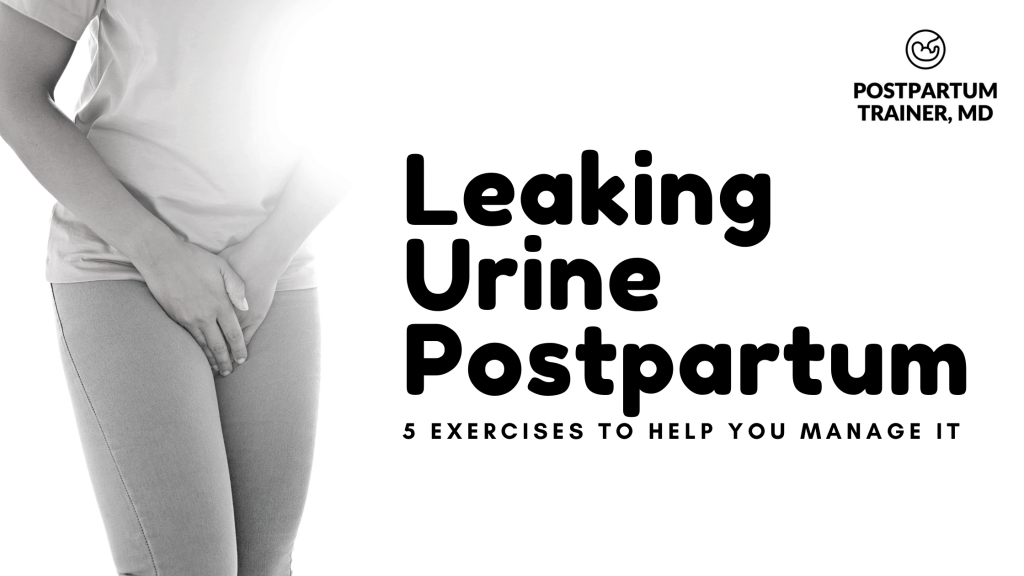
How can I stop leaking urine after giving birth?
In general, there are 5 things you can do to help manage postpartum urinary incontinence.
- Decrease your intake of bladder irritants
- Improve the strength of your pelvic floor muscles
- Train your bladder
- Decrease excess body fat, and
- Manage your fluid intake
Let’s go over each one by one.
#1 Decreasing Bladder Irritants
The easiest thing you could do to decrease urinary leakage is, change your diet.
To get started, you need to stop drinking things that irritate your bladder and potentially worsen your symptoms.
These are known as “bladder irritants.”
Here is a list of the most common bladder irritants.
- Coffee
- Alcohol
- Spicy foods
- Citrus fruits
- Tomatoes
- Chocolate
- Soda
- Other carbonated drinks like sparkling water.
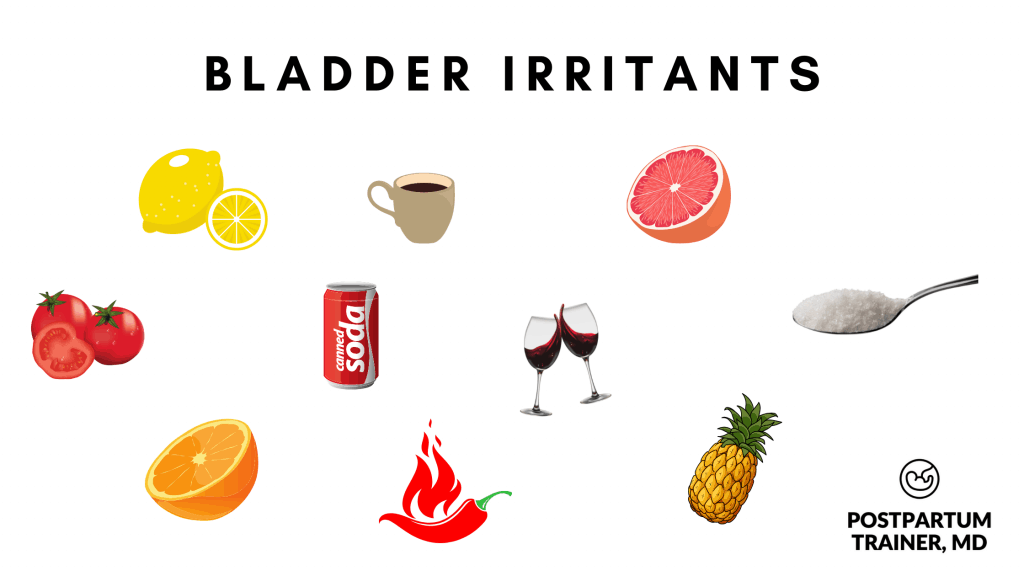
As you can see, beverages or foods with a high acid or high caffeine content are the most common culprits.
#2 Pelvic Floor Exercises
The next important thing you could do to improve postpartum incontinence is pelvic floor work.
It is always a good idea to strengthen these muscles in the postpartum as they almost always get stretched and weakened during pregnancy.
The pelvic muscles include:
- Puborectalis
- Pubococcygeus
- Illiococcygeus, and
- Coccygeus
These muscles act as a sort of hammock or sling to hold up your bladder and rectum.
Weakness in these muscles leads to pelvic floor dysfunction which can manifest as urine leakage and even pelvic organ prolapse, later in life.
There is even research to show that these exercises can be effective in pregnancy itself!
So let’s discuss the best pelvic floor muscle exercises you could start doing today.
As always make sure you have received clearance from your OBGYN prior to engaging in any exercise program in the postpartum period. Additionally, if any exercise causes pain or discomfort, stop.
Kegel Exercises
The kegel is probably the most important pelvic floor exercise you could perform in the postpartum period.
It is super easy and literally can be done anywhere, at any time.
You can do it in the sitting, standing, quadruped, or lying position.
The idea is that you want to tighten the muscles of the pelvic floor as if you are trying to prevent yourself from peeing or pooping.
Don’t engage the glutes or leg muscles- you really want to focus on the pelvic floor and not any other accessory muscles.
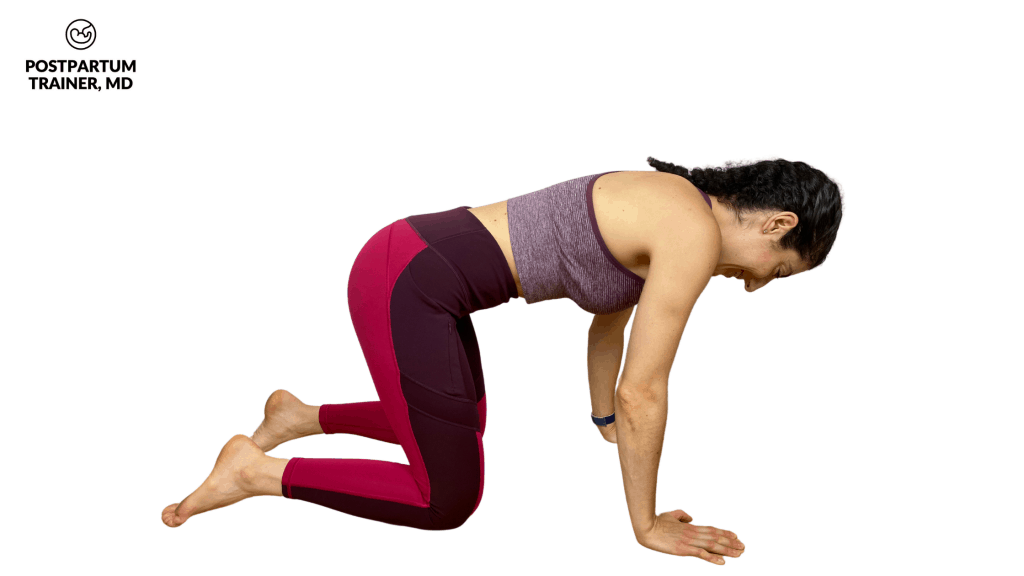
Modified side planks
The modified side plank is another great exercise to strengthen your pelvic floor postpartum.
It also has the advantage of strengthening your core muscles as well!
Hold the top position for 10-20 seconds while squeezing your pelvic floor muscles.
Make sure to train both sides of your body equally.
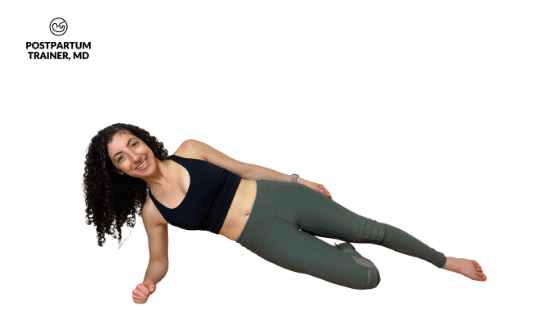
Bird dogs
The bird dog is a fun exercise you can do to train the core, the glutes, and the pelvic floor.
From a quadruped position, you will lift up your arm straight out in front of you so that it is parallel to the floor while kicking back the opposite leg straight out behind you.
Make sure to squeeze your glutes of the top leg, and engage the core and pelvic floor in the top position.
Hold the top position for a few seconds and repeat using the opposite arm and leg.
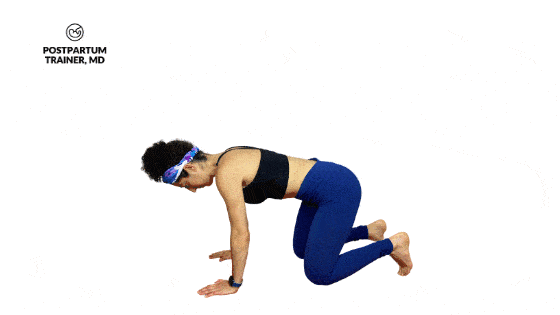
Dead bugs
The dead bug is probably one of my favorite pelvic floor exercises.
Lie down on your back with both knees bent.
From here, simultaneously drop one arm straight out behind you and the opposite leg straight out in front of you.
Hold this end position and focus on engaging your core, squeezing your pelvic floor, and activating the glute of the bottom leg.
Repeat this exercise using the opposite arm and leg.
When this becomes easy, feel free to add ankle weights!
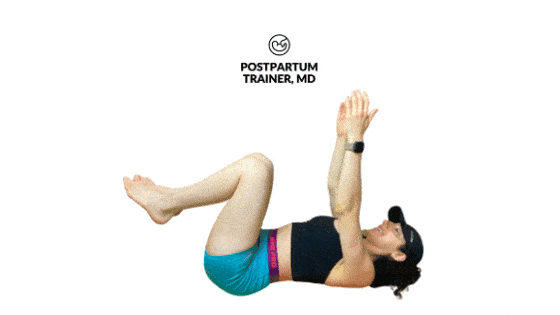
Pelvic tilts with glute bridge
The pelvic tilt with a glute bridge helps to activate the pelvic floor, glutes, legs, and abs all in one exercise!
So first, get into the posterior pelvic tilt position by lying on the floor with your knees bent.
Flatten out your lower back against the ground by engaging your abs.
Now lift up your hips by pressing down into your heels and squeezing your glutes.
Hold this top position and really focus on squeezing your pelvic floor muscles.
Make that mind-muscle-connection!
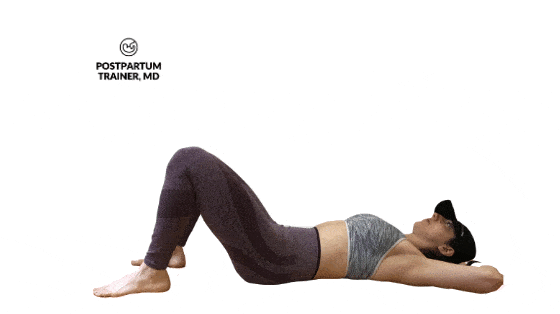
Get My Entire Guide On The Best Exercises For New Moms For Just $1

You can my a step-by-step guide on the best exercises for new moms with pictures in one convenient PDF for just $1. That way, you can print it out and have it with you as you go through the 20 min workout!
#3 Bladder Training
Another way you could stop the loss of urine after giving birth is by training your bladder.
As funny as this sounds it actually works!
When you have the loss of bladder control, you must train your bladder by creating “toilet time”.
This means every 2-3 hours, whether you have to void or not, you go to the toilet and let some urine out.
Do not sit on the toilet waiting for urine to come. If you don’t void in 2-3 minutes, try again in another 2-3 hours.
This way, your bladder will never be completely full, which can increase the symptoms of incontinence.
#4 Decrease body fat
The fourth thing that can potentially help with incontinence is losing excess body fat. This is especially true if you had excessive weight gain in pregnancy, are overweight, or are obese.
Think about it.
If you have a large midsection, that excess weight puts extra pressure on your core and pelvic floor muscles, which can further worsen the symptoms of leakage.
The good news is- you don’t need to lose a massive amount of weight.
Even a modest decrease can help!
Try not to lose more than 1-2lbs/week to maintain a manageable rate of progress.
Feel free to check out The Busy Mom’s Nutrition Plan For Fat Loss for a simple step-by-step nutrition guide created specifically for postpartum women.
You will learn exactly what foods you should eat and when you should eat them so that you can maximize fat loss.
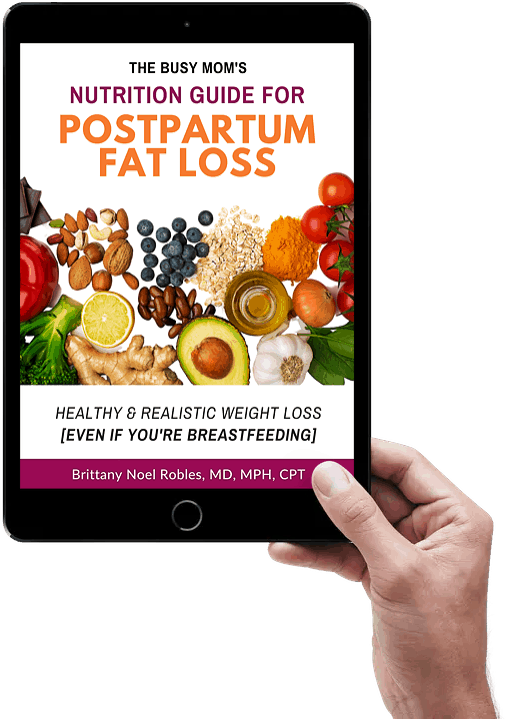
#5 Stay hydrated but don’t over drink
Drinking too much water coupled with weak pelvic floor muscles can be another factor contributing to your inability to control your bladder.
Although hydration is key in the postpartum period, (especially if you are breastfeeding), you must pay attention to just how much you are actually consuming.
In general, you don’t want to drink more than half your body weight (in lbs) in water per day.
For example, if you weigh 150 lbs, you should not drink more than 75 oz of water per day.
If that is too complicated, then just take a look at your urine.
If your urine is dark yellow, you are dehydrated and need to increase your intake of water.
If your urine is colorless, you may be drinking too much water.
An optimally hydrated individual will have a pale yellow urine color.
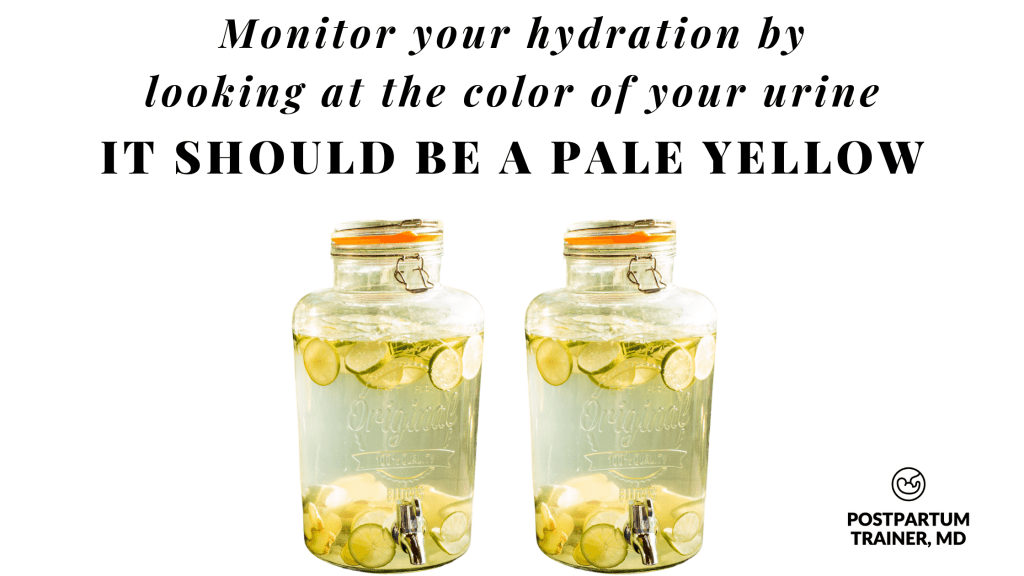
#6 See your gynecologist
Lastly, you should definitely schedule a visit with your gynecologist if these symptoms persist.
Your gynecologist can:
- ensure that your urinary incontinence is not caused by something that needs a more thorough medical intervention
- screen you for urinary tract infections
- refer you for pelvic floor physical therapy
As always make sure to keep regular yearly appointments with your gynecologist in addition to your postpartum appointments.
#Bonus tip: Get these pads
This isn’t to manage the symptoms, but it can be helpful for when you don’t have time to go to a bathroom.
These highly absorbent organic pads have great reviews on Amazon!
How long does incontinence after childbirth last?
Incontinence after childbirth can last anywhere from several weeks to a year.
The time frame depends on several factors including:
- how stretched and weakened the pelvic floor muscles are,
- the amount of tone you are able to establish in the pelvic floor muscles, and
- the presence of other pathologies.
If you have postpartum incontinence that is not improving after exercise, modest weight loss, bladder training, and decreasing the consumption of known bladder irritants, you should speak with your doctor.
what causes postpartum urinary incontinence?
Postpartum incontinence is generally caused by weakness of the pelvic floor, weakness of the urethral sphincter, and nerve damage.
You see, the bladder functions in two ways:
- It relaxes to allow filling, and
- Contracts to allow emptying
During filling, the detrusor (aka the bladder muscle) relaxes allowing the bladder to expand with urine. At this point, the urinary sphincter should be closed.
As your uterus grows, it places extra weight on your pelvic floor, weakening these muscles. In addition, the hormonal changes of pregnancy can also lead to a general relaxation of muscles, joints, and ligaments.
Lastly, as your baby passes the birth canal, it can compress and damage the pelvic nerves that assist in bladder control.
As a result, the sphincter can lose its tone, allowing urine to leak whenever extra pressure is placed on the bladder.
This can happen during coughing, sneezing, laughing, or lifting.
This is known as stress incontinence.
Urge Incontinence
Alternatively, another type of incontinence can be caused by the detrusor muscle contracting abnormally.
This is called an overactive bladder. It is less likely to be the cause of your symptoms.
is bladder leakage normal after pregnancy?
So how common is bladder leakage is after pregnancy?
This systematic review found that 33% of new moms experience postpartum incontinence within the first 3 months postpartum.
Additionally, it showed that women who had a cesarean section were 50% less likely to experience incontinence compared to women who had a vaginal birth.
Another big study identified common risk factors which include:
- vaginal delivery
- advanced maternal age
- high body mass index (BMI)
- delivering a large baby
is it possible to still leak urine after c section?
Yes, it is possible to still leak urine after a c-section, especially if you were laboring before the surgery.
Your pelvic floor gets stretched and weakened throughout the pregnancy as it has to support your growing baby and uterus.
While vaginal delivery is a greater risk factor, a scheduled c-section doesn’t prevent it completely.
Final Words on Leaking Urine Postpartum
Involuntary loss of urine in the postpartum is a common condition that can be managed conservatively.
Don’t be embarrassed by your symptoms, and seek help if it’s not improving!
Now I want to hear from you.
Did you leak urine postpartum? Were you referred to a pelvic floor physical therapist?
Comment below and let me know!
Get Four Free Workouts To Help Strengthen Your Pelvic Floor & Heal Your Mommy Tummy!

Brittany Robles, MD, MPH, CPT
Brittany Robles is a full-time OBGYN physician, a NASM certified trainer, and a prenatal and postnatal fitness specialist. She holds a Master of Public Health degree in maternal health with a special interest in exercise and nutrition. She is also the co-author of The White Coat Trainer. Learn more about her here.
Sharing is Caring – Send This To A Mom In Need!
References:
- Bozkurt M, Yumru AE, Şahin L. Pelvic floor dysfunction, and effects of pregnancy and mode of delivery on pelvic floor. Taiwan J Obstet Gynecol. 2014 Dec;53(4):452-8. doi: 10.1016/j.tjog.2014.08.001. PMID: 25510682.
- Pires TF, Pires PM, Costa R, Viana R. Effects of pelvic floor muscle training in pregnant women. Porto Biomed J. 2020;5(5):e077. Published 2020 Sep 16. doi:10.1097/j.pbj.0000000000000077
- Thom DH, Rortveit G. Prevalence of postpartum urinary incontinence: a systematic review. Acta Obstet Gynecol Scand. 2010 Dec;89(12):1511-22. doi: 10.3109/00016349.2010.526188. Epub 2010 Nov 5. PMID: 21050146.
- Wang, K., Xu, X., Jia, G. et al. Risk Factors for Postpartum Stress Urinary Incontinence: a Systematic Review and Meta-analysis. Reprod. Sci. 27, 2129–2145 (2020). https://doi.org/10.1007/s43032-020-00254-y

Is it the caffeine content in coffee that needs to be avoided – i.e. does switching to decaf help for incontinence?
Hi Minet,
Thank you for your comment.
Yes because caffeine is a diuretic.
A diuretic acts to inhibit or prevent the production of a hormone known as anti-diuretic hormone. When this hormone is inhibited, your kidneys will not be able to reabsorb water.
This causes your bladder to continue to fill with urine increasing the likelihood of urinary incontinence.
Hope this helps!